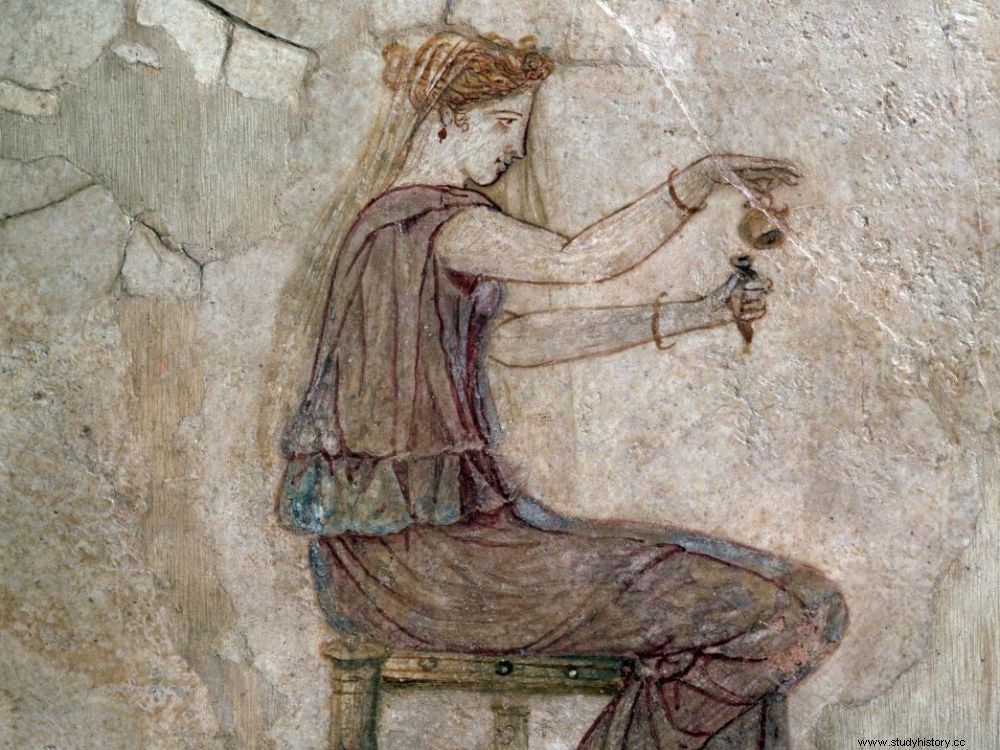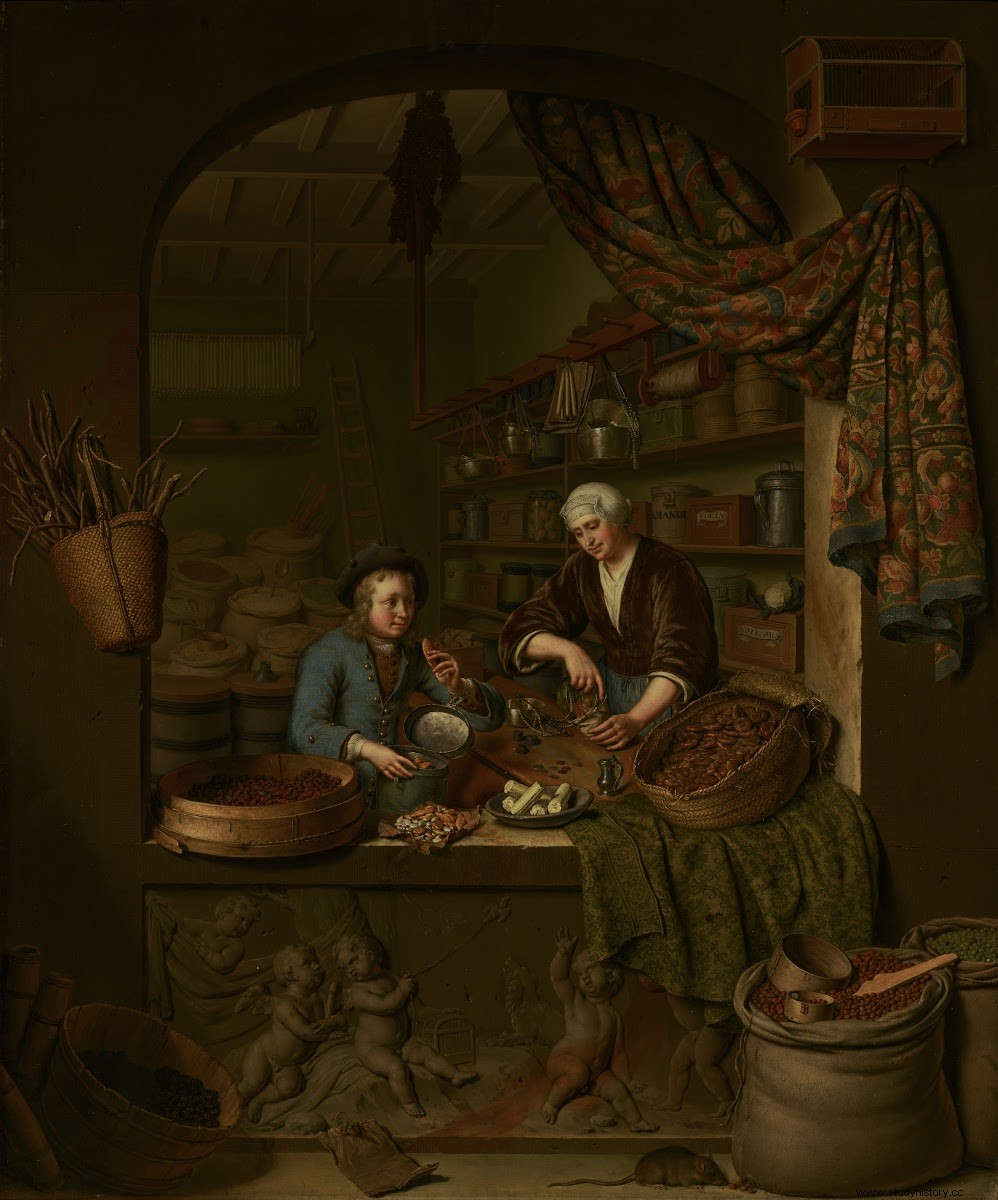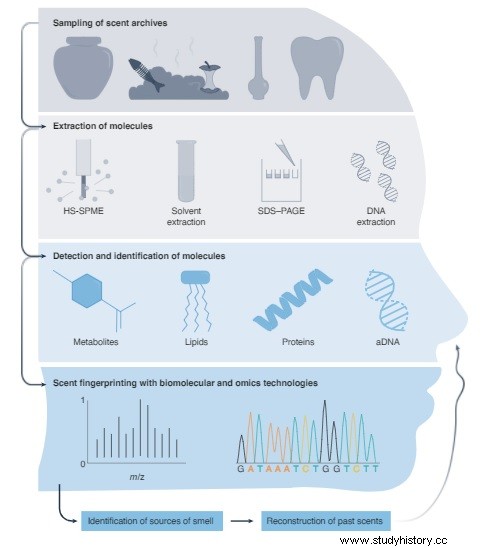A group of researchers from the Max Planck Institute, in Germany, shed light in an educational study on the battery of technologies now available to archaeologists to reconstruct the smells of the past. Science and the Future spoke with Barbara Huber, leading this work.

A seated woman pouring perfume into a vase, depicted in a fresco from the Villa della Farnesina, circa AD 25
Because smells have a strong impact on behavior, it is more than likely that they have played a defining role throughout human history. Unfortunately, if the stones and the bones remain, the fragrances disappear inexorably with time. Barbara Huber, archaeologist at the Max Planck Institute for the Science of Human History, however, assures in a study published in the journal Nature Human Behavior that a new range of technologies, collectively referred to as biomolecular and "omics" sciences, could help archaeologists better understand and recreate these effluvia. Maintenance.
"Comparing eras from an olfactory point of view is not really relevant"
Sciences et Avenir:In the past, were odors more marked than today?
Barbara Huber:Actually, it's hard to answer that question because of the lack of olfactory data that archeology has. We Westerners often assume that our ancestors lived in a world where smells were much more intense than they are today. A world without daily showers, toothpaste, cleaning products or sewage systems, where food scraps and feces were dumped in the streets and incense was burned in staggering proportions (to mask odors in particular, editor's note) . We imagine the past as a space-time totally different from the sanitized places that many of us occupy today. Yet, keep in mind that a large part of the world's population still does not have sewers - around 46%, according to statistics. The degradation in the open air of leftover food and waste of all kinds remains an urgent global public health problem. Likewise, incense is not just a substance of the past, it is still used daily around the world, often rooted in tradition. In short, comparing eras from an olfactory point of view is not really relevant.
To what extent can the knowledge of these smells be decisive, even essential, to understand our past?
Smell has a major effect on how we perceive the world. When odor molecules in the air reach our nostrils and settle on the olfactory epithelium, signals are sent directly to the limbic system, the region of the brain involved in processes related to emotions, cognition and memory. This means that we react to olfactory stimuli even before we are aware of them. They alert us to health risks, alter our behaviors and physiological responses, shape our actions and choices, guide our emotions and trigger our memories. The fact that long-distance expeditions, wars, and trade often relied on attempts to acquire obscure materials with potent olfactory properties, such as incense and spices, testifies to this importance. In short, this sensory dimension can shed light on many aspects of the history of humanity:the nature of rituals, perfumery, hygiene, cooking, trade... But also on more general aspects of the past, from hierarchy and social practices to group identity.
Because smells have a strong impact on behavior, it is more than likely that they have played a defining role throughout human history. Unfortunately, if the stones and the bones remain, the fragrances disappear inexorably with time. Barbara Huber, archaeologist at the Max Planck Institute for the Science of Human History, however, assures in a study published in the journal Nature Human Behavior that a new range of technologies, collectively referred to as biomolecular and "omics" sciences, could help archaeologists better understand and recreate these effluvia. Maintenance.
"Comparing eras from an olfactory point of view is not really relevant"
Sciences et Avenir:In the past, were odors more marked than today?
Barbara Huber:Actually, it's hard to answer that question because of the lack of olfactory data that archeology has. We Westerners often assume that our ancestors lived in a world where smells were much more intense than they are today. A world without daily showers, toothpaste, cleaning products or sewage systems, where food scraps and feces were dumped in the streets and incense was burned in staggering proportions (to mask odors in particular, editor's note) . We imagine the past as a space-time totally different from the sanitized places that many of us occupy today. Yet, keep in mind that a large part of the world's population still does not have sewers - around 46%, according to statistics. The degradation in the open air of leftover food and waste of all kinds remains an urgent global public health problem. Likewise, incense is not just a substance of the past, it is still used daily around the world, often rooted in tradition. In short, comparing eras from an olfactory point of view is not really relevant.
To what extent can the knowledge of these smells be decisive, even essential, to understand our past?
Smell has a major effect on how we perceive the world. When odor molecules in the air reach our nostrils and settle on the olfactory epithelium, signals are sent directly to the limbic system, the region of the brain involved in processes related to emotions, cognition and memory. This means that we react to olfactory stimuli even before we are aware of them. They alert us to health risks, alter our behaviors and physiological responses, shape our actions and choices, guide our emotions and trigger our memories. The fact that long-distance expeditions, wars, and trade often relied on attempts to acquire obscure materials with potent olfactory properties, such as incense and spices, testifies to this importance. In short, this sensory dimension can shed light on many aspects of the history of humanity:the nature of rituals, perfumery, hygiene, cooking, trade... But also on more general aspects of the past, from hierarchy and social practices to group identity.
Read also "Archaeology of the invisible":thousand-year-old Egyptian perfumes revealed by technology

"A grocer's shop" by Willem van Mieris, 1717. Credits:Mauritshuis, The Hague
Could odors play specific social roles?
Absolutely. In ancient Egyptian society, for example, there was an "olfactory hierarchy":the types of perfumes people wore were intimately linked to their social status. Some smells were reserved for the gods or the pharaoh, while others were specific to certain professions. On this subject, one can refer to the works of the Egyptologist Dora Goldsmith, "Fish, poultry and stench in ancient Egypt" (2019). In it she states that the occupation of the fisherman, who worked all day in the dangerous and smelly swamps to catch fish, was considered the most degrading of all occupations because of the stench and the risk involved. /P>
To reconstruct the smells of the past, a rich toolbox available to archaeologists
Secondary metabolites. Important for the defense of plants, secondary metabolites also give them particular scents. They can be extracted from ancient organic residues using a wide variety of methods. The extracts are then analyzed by mass spectrometry or by gas or liquid chromatography, which allows the separation and determination of the mass of individual molecules in a residue. Analytical standards and mass spectra libraries, containing reference mass data, are finally used for compound identification.
· Old lipids. Lipids are mostly water-insoluble molecules, such as fats and oils, and are usually extracted from ceramic shards and sediments. Once sampled, they will be analyzed by gas chromatography or spectrometry, then identified, again, using reference libraries and analytical standards.
· Ancient proteins. Essential nutrients for humans, proteins can be found preserved in dental calculus, tissues or even food residues. Again, there are different ways to extract them and turn them into smaller peptides (short chains of amino acids that work like building blocks for proteins). Peptides can then be analyzed using a mass spectrometer and identified based on protein sequence databases.
· DNA extracts. The carrier of life's genetic information, even ancient DNA can be recovered from teeth, plants, and mummified tissue.
· "Omics" methods. Scientific approaches with the suffix "omics", such as genomics, metabolomics, and proteomics are large-scale, high-resolution, non-targeted analyzes of specific biomolecules. For example, proteomics studies all the proteins in a sample rather than a single protein, unlike analyzes that target only a selected subset of proteins.
· Bioinformatics. This application of computer science to the analysis of biological data is now essential due to the enormous amount of complex data obtained by omics methods.
Where are we today in terms of reconstructing the smells of the past?
We are sorely lacking in tangible material evidence. This is why most of the studies carried out on ancient odors are essentially based on written sources or visual representations. But these studies come up against the difficulty of identifying the names of attested ancient plants. For example, the majority of cuneiform or Egyptian texts do not include any mention of fragrant substances used to flavor food, to heal or to make perfumes. And even though these plant names are mentioned in these texts, they can rarely be translated and related to modern taxonomies with certainty. Finally, this plant nomenclature is dynamic:when it passes from language to language, a denomination can sometimes completely change its meaning.

A diagram explaining how ancient odors can be studied via biomolecular approaches. Credits:Barbara Huber/Max Planck Institute
"There is growing interest in the archeology of the senses"
So should we give up trying to find these lost fragrances?
Especially not ! To date, only a few biomolecular and "omics" analyzes (see box above) fragrant substances of the past have been realized. However, we believe that these studies open up a whole new level of identification of ancient odors. It is now possible to recover and analyze rare molecules stored in old "olfactory archives". These archives can be archaeological objects associated with the use of aromatic substances, such as incense burners, perfume bottles, cooking pots or storage containers. Larger items with more general use, such as city streets, or even bodily items (dental calculus or mummified remains) can also serve as scent archives. But I think it is important to bring together the different sources of information, linking biomolecular studies to ancient texts, representations and archaeological and environmental context. By harnessing these innovative approaches, we could uncover new aspects of the ancient world, the evolution of our societies and cultures, and our evolution as a species.
Is your study a way to encourage archaeologists to take a closer look at these smells from before?
Yes, this article is somewhat of a call to action, a way to encourage archaeologists to take a closer look at those ancient smells, as more and more technology allows it. Moreover, the archeology of the senses is arousing growing interest. Over the past decade, many studies have focused on sensory aspects of the past such as sound, smell, touch, or emotions. If the sampling of organic substances during excavations, such as ancient odorous substances, became more systematic, we could study the olfactory landscapes of the past in a more comprehensive way. However, our goal was to identify the smells that have been used in the past and to study their social and cultural implication. Recreating them is another story. Research groups are working specifically on this aspect. I am thinking of Caro Verbeek and other members of the Odeuropa consortium…
